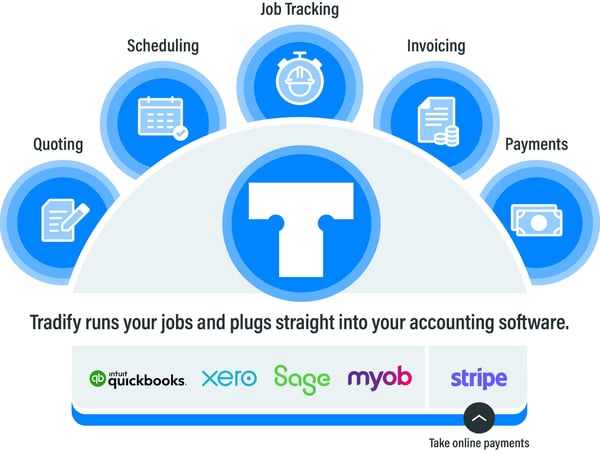How to Start a Carpentry Business - A Builder’s Guide to Going Out on Your Own
by Team Tradify, January 19, 2025

Table of Contents
After spending years working for someone else, you might decide that you’ve got the experience, the connections, the tools, and the training to go out on your own. You’re ready for a new challenge – but where do you start? To start a carpentry business, you need a solid business plan, financing and to know your legal responsibilities.
As a carpenter, you’re no stranger to hard work. This is a great start because starting a carpentry business isn’t easy. Your experience and knowledge as a carpenter or builder will provide a solid foundation to get you started, but you’ll need new skills as a business owner too.
This guide is specifically for tradespeople thinking about starting a carpentry business or working as a self-employed building contractor. It’s packed full of information, templates and steps – everything you need to know about turning your hands-on skills into a successful and profitable carpentry business.
Need a hand coming up with a name for your carpentry business? Try our Electrical Business Name Generator!
Short on time? Skip ahead:
- Writing a carpentry business plan
- Financing your carpentry business
- Your responsibilities as a carpentry business
- Marketing your carpentry business
- Learn from others in the industry
- Build your business
1. Writing a carpentry business plan
Writing a business plan can take a little time, but it’s a necessary step in starting your carpentry business. As a carpenter you’d know better than anyone that a solid foundation is key to success. To give yourself the best possible start, you need to lay the foundations of your business with a solid business plan. This will help you be clear on your goals and how to achieve them, as well as more practical things like financing and marketing.
While things often don’t work out exactly as planned, having a business plan will help mitigate any problems you might encounter along the way.
For an in-depth guide to writing a trade business plan, read Tradify’s No-Nonsense Business Plan Guide for Contractors and Tradespeople.
To make things easier, we've also put together a business plan template specifically for trade businesses.
Registering your contracting business
Time to make it official — the next step is to register your business. Read the points below for information on registering a business in your region. When deciding on your business structure, think about your goals for the future. Are you looking to grow, or fly solo forever?
- 🇺🇸 USA - you can apply for a sole proprietorship or form an LLC.
- 🇬🇧 UK - most people register as sole traders or limited companies.
- 🇦🇺 AU - you’ll need to apply for an Australian Business Number (ABN).
- 🇳🇿 NZ - you’ll register as either a sole trader (Ministry of Business) or a company (NZ Companies Register).
2. Financing your carpentry business
When starting a business, you need to spend money to make money. Getting started will come at a cost – but how much will depend on your structure (self-employed contractor or registered business) and the goals you’ve established in your business plan.
Borrowing money
So, where will you get the money to fund your new business venture? You might have enough saved up yourself. If so, good on ya! But if you don’t, you might need a loan to get your business up and running.
You might go into business with a partner, work with a private investor or join a franchise. This will determine the initial set-up cost of your contracting business.
If you do need to borrow, you have a few options:
- Small business loan
- Government loan scheme
- Private investor
Whether you borrow money from a bank, a non-bank lender or a private lender (maybe a family member), you’ll have to show you’ve done your homework.
- A break-even analysis – show your business can at least break even before it makes a profit.
- A cash-flow forecast – how much money is moving in and out of your business and when.
- A sales forecast – estimate future revenue by predicting weekly, monthly, or yearly sales. This isn’t easy when you’re starting, but there are ways. This will help you work out if your business idea is financially viable.
Government loan schemes
Your local government might also have a financial scheme to help new businesses. If your carpentry business is eligible, this can be a great way to access funding that may not need paying back.
- 🇺🇸 USA - SBA provides limited grant funding to eligible businesses.
- 🇬🇧 UK - Startup Loans of £500 to £25,000 are available to start or grow your business.
- 🇦🇺 AU - Check if you’re eligible for a variety of grants that vary between states.
- 🇳🇿 NZ - Government grants, advice, and mentoring are available, depending on your business.
Investors
Your third option is to approach an investor. Angel investors are successful entrepreneurs who provide capital for promising business start-ups. Rather than you paying the initial investment back, they often receive convertible debt or a percentage of ownership in return.
- 🇺🇸 USA - Angel Investment Network
- 🇬🇧 UK - Angel Investment Network
- 🇦🇺 AU - Angel Investors
- 🇳🇿 NZ - Angel Association

Purchasing equipment and tools
Unless you already have your own tools, this may be your biggest up-front cost when starting your carpentry business – but they’re also an investment. Your tools are your livelihood and you can’t work without them. Make sure to purchase reliable, quality products that (with proper maintenance!) will last you for as long as possible.
Check out our articles: 'Best Tool Belts for Carpenters' & 'Top 10 Hand Tools for Carpenters'.
You may also need a work vehicle. You certainly don’t need the latest truck with all the bells and whistles (not to get started anyway), but you will need something reliable with enough room to store all your tools securely while you’re on the go.
The good news is you can claim tax back on the cost of your business-related tools and equipment — including vehicles!
- 🇺🇸 USA - Business tax write-offs
- 🇬🇧 UK - Expense claims for UK contractors
- 🇦🇺 AU - Expense claims for Aussie tradies
- 🇳🇿 NZ - Expense claims for NZ tradies
Insurance
You also need to think about protecting your tools and equipment. They’re your most important asset. If they go missing or get stolen (unfortunately it happens a lot), you’ll be up the proverbial creek without a paddle.
As well as insuring your tools and equipment, you might also want to consider general liability (in case you accidentally cause damage to someone else’s property) and income protection (if you have an accident and can’t work). You might not have the funds to take out all your insurance policies at once, so look for a reputable provider of small business insurance – they’ll be able to help you make a plan.
Read our article on business insurance for tradespeople.Learn more about keeping your tools safe.
Accounting and taxes
Tidy books are essential. Staying on top of your admin will ensure that you get paid quickly for all your time and materials, and you’ll avoid any late penalties from the tax man when he comes knocking.
To make things even easier, Tradify also integrates with your favourite accounting software:

Find out if you need an accountant.
Working out what to charge
You make money by charging your customers for the time, skill, materials, and labour required to complete a project – not by plucking a number from thin air.
Here’s what you need to factor in when figuring out your prices:
- Variable costs - These costs vary between projects - your labour is charged by the hour and cost of materials.
- Fixed costs -These are the costs associated with running your business e.g. vehicle payments and insurance. They’re called ‘fixed costs’ because they generally stay the same.
- Other factors - Your pricing should also take into consideration your skills, experience and qualifications, the quality of your materials, and where your target market is located.
Here’s a guide on how to figure out your charge-out rate using our Charge-Out Rate Calculator.

3. Your responsibilities as a carpentry business
As a business owner, you have several responsibilities. Aside from doing good work, treating your staff well and keeping on top of your financial obligations, there’s also the need to comply with any regulations surrounding the carpentry and building industry. This red-tape stuff might not make you money – but it can certainly cost you a lot if you don’t pay attention to it.
Keep the following in mind:
- How your business is going to affect the environment and how you plan to deal with it.
- Local laws around operating a business including employment laws when you hire staff.
- Health and safety regulations and what you must do to comply and keep you and your team safe.
Professional trade associations for carpenters and builders
Becoming a member of a local professional body is a great way to stay on top of what’s happening in the industry – without having to wade through pages of mundane government documents.
To join, you’ll probably need to meet minimum qualification requirements – find out what these are and whether you’re eligible before applying. They usually offer training and professional development opportunities, which can be a huge competitive advantage long-term. It’s good to keep updated with qualification requirements in case you bring on an apprentice or employee.
- USA - Institute of Carpenters
- UK - Institute of Carpenters, British Woodworking Federation
- AU - Carpentry Australia
- NZ - New Zealand Institute of Building
Managing your carpentry business
Running a carpentry business takes more than just skill and experience – you need business acumen too.
At first, managing the daily tasks of a business can feel like you’re juggling way too many balls. The trick is to get rid of the balls you don’t actually need to juggle.
There are core business processes to follow, and you’ll need to focus on each stage of your workflow to figure out exactly what’s required. From there, you’ll be able to streamline your work, become more efficient and increase your work turnaround times.
4. Marketing your carpentry business
Reality check – you’re not going to be the only carpentry business in town. You’ll always be up against the competition – but this is where all the work you’ve done thus far will help.
When marketing your carpentry business, lead with the thing that you do differently or better than anyone else in the market. Yes, some clients will shop around for the cheapest builder, but most will be more interested in why they should hire you. If you can make this clear up front, the price most likely won’t be an issue – and you’ll be well ahead of the competition.
Figuring out your target market
While it might be tempting to be everything to everyone, this isn’t the smartest course of action. With tens of thousands of carpentry businesses and self-employed contractors around the world, finding your niche will not only help you create a steady stream of revenue but also establish a loyal customer base.
To define who your ideal customer is, think about ways you can add value. This could be making your services accessible to a new group of people (think new housing developments or subdivisions) or something extra you can offer to get a leg up on the competition.
As you design your carpentry business, every decision you make should be specifically directed at the type of client that you want to attract.
To work out your niche, here’s what you need to do:
- Decide on what area/s you want to work in. Also consider whether your customers will be residential or commercial (or both), or other contractors.
- Research your competitors and identify any service gaps in the local market that you could fill.
- Make sure that opportunities in the market align with your skills and interests.
- Narrow down the services you’ll offer based on your experience and the service gaps you’ve identified in the market.
- Estimate your niche’s profitability by collecting data on your competitors’ gross margins.
Competitive advantage
When researching competitors in your area, think about:
- What you can do differently, or better
- How you can stand out
- Whether existing businesses offer potential partnership opportunities
Your marketing plan
In today’s digital age, there are many options for getting the word out about your business, and it can be a little daunting at times. But remember – the customer is at the centre of every business decision that you make, so go where your customers are.
To start with, at least consider:
- Building a website
- Google Business
- Photography
- Reviews
- Social media platforms:
- Listing with local business directories:
Word of mouth is still one of the best – and least expensive – forms of marketing. Be proud - tell your friends and family about your new business and get them to spread the word on your behalf. It only takes a few new clients, a couple of well-done jobs, and you’ll be on your way.
To help with your marketing strategy, we’ve developed a practical marketing toolkit for tradespeople. It’s full of examples, tips and tactics to help you successfully market your trade business.
5. Learn from others in the industry
Podcasts are a great way to listen and learn while driving to and from jobs. Tradify's own podcast is made specifically for tradespeople looking to start or grow their business. Most phones have built-in apps for podcasts, or you can try Spotify.
With 29 million podcast episodes available across all the different platforms, you’ll be sure to find something worth listening to. And, because it’s a growing medium for content, you won’t have to put up with too many ads.
Behind the Tools with Tradify
Tradify's podcast is called Behind the Tools. It's an inside look at tradespeople from all over the world. Each episode we bring on a guest to answer the real questions you have about life in the trades, running a business, and how to overcome the challenges that come with being a tradesperson.
You can watch the videos on YouTube or listen to our podcast on your favourite platform:
6. It’s time to build your business
For most tradespeople, running a business or working as a self-employed contractor is a tried and true way to live a better life. You’re calling the shots – the hours you work, what jobs you take on, how much you charge. It means spending more time with the family and doing the things you love. And while it’s not always about the money, making more money is a welcome side-effect of going out on your own.
Building a business from scratch isn’t a walk in the park. There’s a lot to consider, but just as you would tackle a new building project, a strategic, step-by-step approach will see your business up and running in no time.
Work your way through this guide and be sure to get your business plan sorted. Keep your goals and objectives in mind and continually hone your competitive advantage so that your reputation grows. Start right by setting yourself up with carpentry job management software that will scale with your business. It’ll pay off as your business grows and you begin to hire staff.
Already looking at hiring an apprentice? Download our Apprentice Carpenter Interview Question Template!
Tradify is a must-have tool for new businesses. It’ll help you take care of:
If you're looking for carpentry software to run your business — try Tradify for free!
Download our free Construction Business Plan Template to help you get started!
Related articles

Hard Water, Smooth Results: How SoftPure Water Scaled

Tradify Helps TurnCo Building & Maintenance Price Jobs Right

Best Black Friday Deals for HVAC Technicians & HVAC Businesses
Give Tradify a go for free!
Save 10+ hours/week on business admin with the highest-rated job management software for tradespeople.
With free one-on-one training and phone support, it's never been easier to get started.








